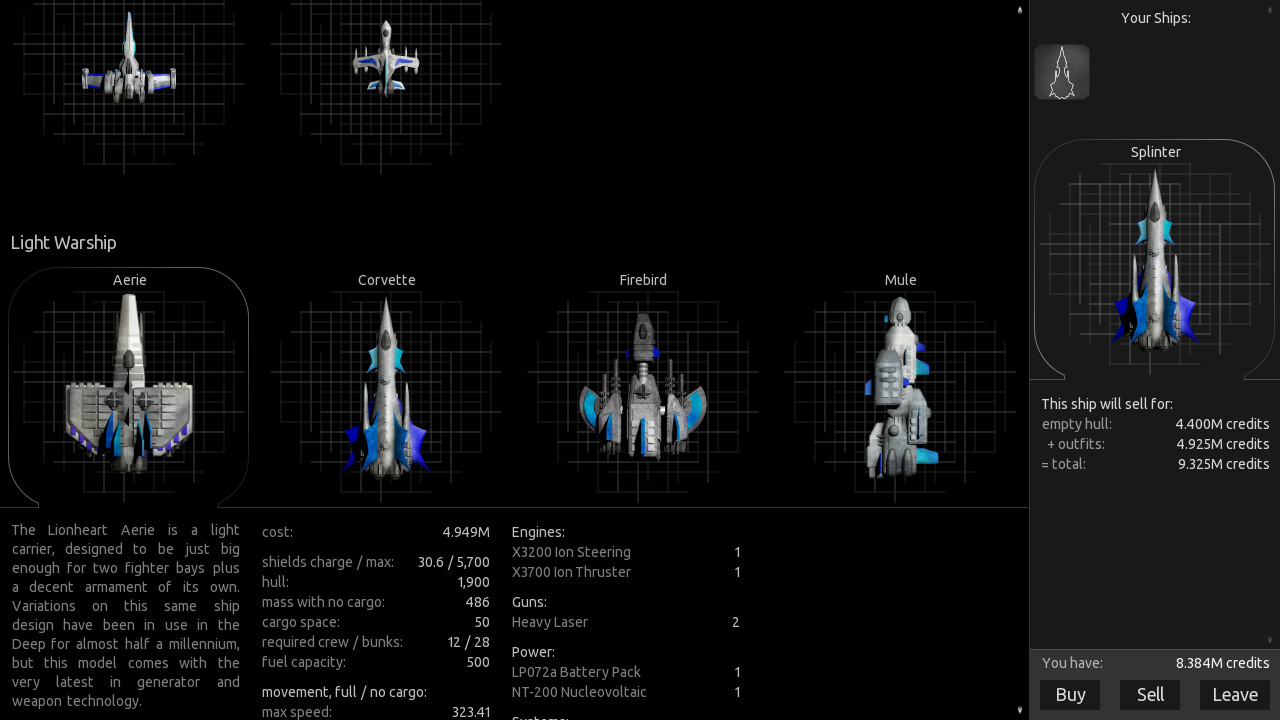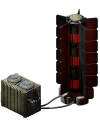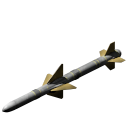
Weapons
Ships can be equipped with two different types of weapons: guns and turrets. Each ship model has a fixed number of gun ports and turret mounts, but there are no constraints aside from space on what particular weapons will be mounted there.
A “gun” fires in the direction in which your ship is facing. This includes homing missiles, which initially fire in that direction but can then turn under their own power to track their target. Other guns include lasers, which fire in a continuous beam, and energy projectile weapons such as blasters and plasma cannons. Some guns, such as particle cannons, are so large and draw so much power that they are typically only installed in capital ships, but they still only occupy a single gun port and it is not unheard of for a small ship to carry one enormous gun in lieu of several smaller ones.
Although fixed guns cannot swivel once installed, they are set up to point slightly inward rather than firing perfectly straight, so that the beams or projectiles will converge at close to their maximum range. For large ships with widely spaced guns, this is believed to increase their effectiveness, especially against small targets that might otherwise be able to fly in between the beams.
Turrets can fire in any direction, and typically have sophisticated tracking systems that can compensate for the relative velocity of a target. (But, if you do not have a target selected, turrets just fire straight forward.) As with guns, some turrets are much larger and more powerful than others. Turret mounts can also be used for anti-missile systems, specialized weapons that do not damage enemy ships but instead target enemy missiles, destroying them before they come close enough to strike your ship. If it seems pointless to you to sacrifice the firepower of an entire turret just for limited protection against missiles, you may think differently the next time you find your ship being bombarded by missiles fired by pirates who are too cowardly to close to within turret range!
The rise of anti-missile technology has prompted changes in missile design to compensate. In particular, some missiles (such as the Sidewinder from Lovelace Labs, which ironically is also the primary manufacturer of anti-missile turrets) have ablative armor that makes them harder to destroy. Also, if a ship has several missile launchers of the same type installed, they will fire in salvos rather than one at a time, to increase the odds of one missile getting past a ship’s defenses while it is busy shooting down another.

Fighters and Drones
If your ship has any “fighter bays” or “drone bays,” you can purchase fighters and drones in the shipyard for it to carry. Fighters and drones do not have hyperspace capability, so if you have launched them you must recall them to your ship before entering hyperspace to a new system. Otherwise, they behave the same as ordinary escorts. If you accidentally leave a fighter behind, return to that system as soon as possible to retrieve it! The pilot will probably be very relieved to see you.

Heat
Although the vacuum of space it terribly cold, it is also a very good insulator. With no air to carry heat away, your ship relies purely on radiating it out as infrared energy. If enough heat builds up and your ship’s internal temperature exceeds the maximum level, it will temporarily shut down until it can cool off again. Since weapons generally produce more heat than anything else, a ship may seem to be maintaining a safe temperature until it is in the thick of combat, but can then suddenly overheat and be left as a defenseless target.
It is highly recommended that when outfitting your ship, you pay attention to the “heat generation” numbers, including the combined value for when the engines and weapons are all firing. You may also find it useful to test drive your ship by taking it out into an unoccupied region of space in a safe star system and firing your weapons and thrusters simultaneously, to make sure that the heat and energy consumption are both acceptable.
Heat may also be used as a weapon. Pirates, in particular, are notorious for running their ships hot, and you may be able to find some weapons that heat up the target ship in addition to damaging it. For a pirate vessel coming in with all guns blazing, that little extra bit of heat may be enough to push it over the edge. Heat weapons are most effective on ships whose shields are down.
Combat
A hundred years ago, in the golden age of the Republic, piracy had been all but eliminated. The slave trading cartels were defeated, Navy ships patrolled every system from Betelgeuse to Tarazed, and most of the remaining pirate outposts were hidden underground bases on resource-poor worlds. But a few centers of pirate activity survived, and with the recent economic downturn and expansion of colonies into new systems, the Navy is stretched too thin to patrol everywhere at once. So, in every corner of the galaxy except for the Deep, there are worlds owned entirely by pirate clans who give neither respect nor revenue to the Republic.
Whether or not you are looking for a fight, sooner or later a fight will find you. The simplest response remains the best: run away, or look for help. If you fly in the direction of any government ship, they will be more than willing to shield you from the pirates. If you are near a planet, landing on the planet will shake all but the most persistent pursuit. And if you are too far away from a planet, you can always try making a hyperspace jump and hoping the pirates will not follow. But bear in mind that your ship must be almost stationary before initiating a hyperspace jump, so if you are taking impacts from powerful weapons you may not be able to come to a stop for long enough to make the jump.
If you're unable to run away, you can always hail the pirates and offer them a bribe. Or, you can jettison a few crates of cargo (in the ship info panel) and make your escape while the pirates are busy picking them up.
If you decide to engage in combat, strategy can be as important as brute force. If attacked by multiple adversaries, try to split them up and deal with them one at a time; even if you are in a capital ship, you can be taken down by three or four interceptors operating in tandem. If your weapons have a longer reach then theirs, try to keep them just outside their maximum weapon range. Focus your fire on one ship at a time rather than continuously choosing new targets. Use asteroids for cover. If you are in a light, fast ship, change direction frequently to dodge the shots from their blasters or cannons. Do your best to dodge missiles until your adversaries run out of ammunition. And even though missiles cost money, if you’re facing a stronger ship don’t hesitate to bombard them from a distance before closing in for the kill.

Secondary Weapons
Weapons that use ammunition do not automatically fire when you press the primary fire key. Instead, you must select the weapon you want with the weapon select key (‘W’ by default) and then press the secondary firing key (‘Q’ by default) to fire it. This is because, against weaker enemies, you may not want to waste ammunition.
Bear in mind, as mentioned previously, that missiles can be destroyed either by anti-missile systems, or by collisions with asteroids. In systems with large numbers of asteroids, you may want to hold off on firing missiles until you are relatively close to your target, and if facing an opponent with anti-missile systems, you can fire at point-blank range to give them less time to shoot down your missiles. Just don’t try that trick with heavy rockets or anything else that has a blast radius, or your own ship will be damaged in the process!
Secondary weapons also include weapons that are powered by hyperspace fuel, but such weapons are quite rare and generally only used experimentally.
By default, any escorts you have will save money by only firing their secondary weapons when faced with an enemy fleet more powerful than your own. Their firing behavior can be adjusted in the preferences or by pressing the “toggle ammo usage” key (‘U’ by default).
Boarding, Plundering, and Capturing Ships
Depending on how strong its hull is, a ship will become disabled at somewhere between 50% hull strength and 10%. By that point it only takes a few more shots to destroy them, but you may be better off leaving them behind and choosing another target. Once there are no hostile ships left in the system, you can come back and plunder disabled ships. Bear in mind that plundering a ship is a criminal act against that ship’s government, not much better than being the one who disabled it in the first place. But if it’s a pirate ship, no one but the pirates are going to complain.
To board your current target, or to board the closest disabled ship if your current target is not disabled, press the boarding key (‘B’ by default). To board a ship you need to match speed with it and come within a certain range, but don’t worry - your autopilot will handle this automatically. Once you are within range your ship’s magnetic grapples engage and link your two ships together.
From here, you have two options. The safe option is to steal whatever you want that is accessible from the exterior of the ship: cargo in the cargo bays, plus weapons, engines and other outfits. The items available to be plundered are listed in the boarding dialog sorted by price per ton, with the most valuable items at the top of the list. Because you cannot install outfits while in deep space, you will need room in your cargo bay to store them, instead. To sell off or install a plundered outfit, visit the outfitter at the next planet you land on. The outfits you stole will be listed as “in cargo,” and you can click on one to sell it or to install it (for free, since you already own it).
The other option is the riskier one: attempting to capture the disabled ship. The boarding dialog displays your calculated chances both of capturing a ship, and of defending your own ship if your capture attempt fails and the other ship’s crew turn around and attack you. Some outfits that you can buy increase your odds either of attacking another ship, or of defending your own. Each one needs a crew member to wield it. For example, if you have ten laser rifles but only three crew left, you only get the bonus from three of the rifles, not all ten. Even without special weapons, crew members can fight. Because of the advantage of using their own ship for cover, crew are generally twice as effective when defending as when attacking, which means that if you are trying to capture a ship with the same number of crew as your own, your odds will be far lower than 50-50.
If you succeed in capturing a ship, some of your crew members must transfer over to it in order to pilot it. That means, in particular, that you cannot capture a ship if you only have one crew member left (i.e. yourself). If a ship has fewer than its minimum required crew, it can still fly, but its controls will intermittently become unresponsive. For example, a ship that requires 5 crew and only has 3 will only respond to controls 60% of the time, which can make it difficult for that ship to land or to fight.
The newly captured ship will be repaired just enough that it is no longer disabled. A hit from any weapon will be enough to disable it again, so you will need to avoid combat until its shields have a chance to recharge.
If a friendly ship is disabled, you can board it to repair it just enough so that it can fly again. And if your own ship is disabled, you can hail a friendly ship and ask it to repair you.
Strategy
In the preferences screen, you can enable automatic aiming and firing, allowing your ship’s computer to control your weapons more precisely than you may be able to. Automatic aiming engages whenever you are firing your primary weapons and pointed roughly toward your target, and will turn your ship to track the target if possible. Especially for long-range weapons like particle cannons, you are unlikely to hit your target without the computer’s help. Unfortunately, all the ships you fight have access to the same precise targeting algorithms, so fancy flying alone will not guarantee you a victory against a ship that is as strong as yours.
Most of the strategy lies in how you outfit your ship. For example, suppose you are flying a sparrow. If you swap out its two beam lasers for one heavy laser (which has a slightly longer range), you can defeat another Sparrow by staying just outside its weapons range. Or, you can install missile launchers and destroy the enemy Sparrow from a safe distance, but then you have to pay for ammunition. Or, you might try upgrading your Sparrow’s shield generator to give you a slight edge in combat: if you break away from the fight, your shields will recharge faster than your opponent’s.
In combat, whichever ship is faster and more maneuverable has a significant advantage. For example, a fast ship can often strafe around a slower ship and keep out of range of that ship's forward-facing main guns. A fast ship can also choose when to disengage from combat, and can often avoid missiles just by running away from them. So, don't make the mistake of only prioritizing strength at the cost of speed.
If fighting multiple opponents, a useful strategy is to split them up by flying away (so that the faster one will reach you before the slow ones). That way you can fight them one by one. If you can’t do that, your best strategy is to destroy the weakest ships first.
Once you acquire escorts or get involved in the main plot line of the game, you will often be fighting with an entire fleet on your side. You can assist your fleet by acting as a diversion and drawing a large chunk of the enemy fleet away to follow you, or by going where the fighting is thickest and concentrating your fire on whichever ships the rest of the fleet is attacking. Or, you can load up your ship with anti-missile systems and just play a support role by shielding your allies from missiles. Also, some fleets include ships that will lurk on the fringes of the battle bombarding you with missiles; if you have a fast enough ship to chase them down, you can take them out before they have time to unload all their ammunition at your allies.
If you are heavily damaged in a fleet vs. fleet battle, you can use your allies as shields, because you can fire past them but your enemies cannot. In particular, if an allied ship has been destroyed and is in the process of exploding, you can use it as a shield without costing your fleet anything, because that ship is already dead. Just be sure you aren’t too close when the final explosion happens!
If your fleet is jumping into a system where you expect a fight, hold down the jump key until all your ships are ready to jump, then release it to jump together. Otherwise, your ship will be the first to enter the system and all the enemies will concentrate their fire on you.
0 commenti:
Post a Comment